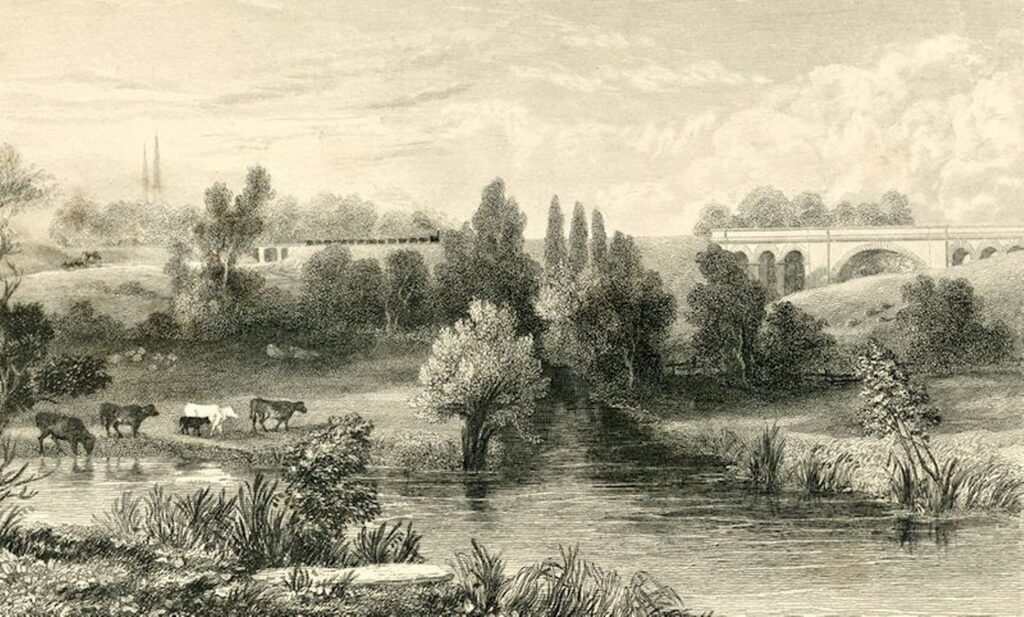
In a second article from the latest edition of Heritage Park Times, courtesy of Historic Coventry Trust and the Heritage Lottery Community Fund, Parks for People Programme, Peter Walters writes…..
On 17 September 1838 a landmark in the pioneering age of railways was reached as the first passenger train puffed its way into Birmingham from London.
At just over 112 miles long, the London and Birmingham Railway was the first mainline link between the capital and the rest of the country. It had taken five years to build, employed 20,000 people and cost £5.5 million, more than double the original budget.
Its engineer, Robert Stephenson, had carved out the route with tunnels, bridges, cuttings and viaducts, including the structure that crossed the River Sherbourne as the line made its way into Coventry.
The Sherbourne Viaduct, a central brick arch with three smaller arches on either side, is still part of the main West Coast line and will now become a fascinating historical feature in the new Heritage Park.
Its Grade II listing, conferred by English Heritage in 2015, described it as an early example of a structure dating from the pioneering phase of railway development, well-detailed and skilful in handling the engineering challenge of crossing the River Sherbourne, and designed by one of the most important transport engineers of the nineteenth century.
To build it, the railway company paid local landowners, including Mr Eyre Evans Kelly of the Charterhouse, almost £3000 for the fields that it crosses, as well as compensation for buildings destroyed and rights of access affected.
Beneath the viaduct’s embankment, largely hidden from view, lies what local folk have long known as the Folly Lane tunnels. As part of the Heritage Park development, the decorative portals leading into the main tunnel are set to be restored.
The Railway Heritage Trust, which funds historic restoration projects around the rail network, has indicated that ‘in principle’ it is prepared to offer a grant to help to restore the portals.
Tim Hedley-Jones, Director of the Trust, said, “I visited last year and was very impressed. We have not given any grant to the area in the past, but we are potentially looking at doing so now.”
Close to the viaduct, the Humber Road junction marks the beginning of the Coventry Loop Line, opened in August 1914 to divert goods traffic away from the city’s congested mainline station.
The loop line, which stands at the heart of plans for walking and cycling trails in the new Heritage Park, was only very rarely used for passenger journeys.
In its heyday it serviced Coventry Wholesale Market, the Morris sidings at Courthouse Green, Coventry Ordnance Works and Bell Green goods yard, but in October 1963 the junction was severed as part of the electrification of the West Coast line.
After that it was used as a long siding on Gosford Green, principally for traffic destined for the motor industry. The line finally closed in 1981 when its main user, Chrysler’s Linwood Plant in Scotland, was shut down.
After forty years it’s now coming back to life as part of a walking and cycling network that will eventually link Gosford Green and the Charterhouse.
Phase One, a walkway linking Gosford Green with Humber Avenue, close to Gosford Park School, opened last September. Work on Phases Two and Three, making a connection between Humber Avenue and the Folly Lane tunnels, via Terry Road, is underway and will be completed later this year (2023).
Graham Tait from the Historic Coventry Trust says the project has attracted a number of funders, including Severn Trent Water’s Community Fund, which has contributed almost £200,000.
The aim, he adds, is to improve access to the area so that Charterhouse can open itself up to its neighbours.
“We have three schools in close proximity and we want to get them involved. For a long time it’s been a hidden area and it’s been our vision that Charterhouse should fit within a wider landscape.”
Opening up the area, he says, does not mean making it a well-manicured parkland.
“Local residents value the wildness of it and we want to ensure that it remains as wild and natural as possible.”
Find out more on the Heritage Trust website, where you can order tickets to visit the Charterhouse.
